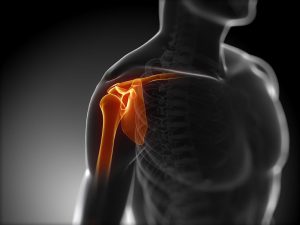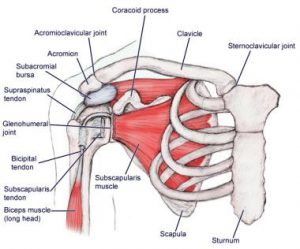I read a Frederic Delavier’s book « Strength Training Anatomy » and there is good stuff.
Shoulders injuries are frequent in bodybuilding because we want develop all deltoid muscles. To do this, we must perform a signigicant number of repetition and movements thus multiplying the risk of injury.
It’s worth remembering that, in comparison with the solid hip’s articulation where the femur head is deeply embedded in the pelvic cavity of the pelvis, shoulder’s articulation, which must be very mobile to allow arms to move in all direction, is very little embedded.
Shoulders can thus be defined as a joint to muscular fixation, the maintenance of the humerus head on the scapula’s glenoid cavity is mainly ensured by a complex musculo-tendinous ensemble.
Although in bodybuilding most injuries occur during shoulders training, it’s rare to see this muscle directly injured. The wound are generally much deeper and appear most often during a false movement or after a long wear by friction of tendon structure reinforcing the articular capsule.
While in other sports of violent contact (such American football) or rapid arms movements (such as throwers) can result in serious injuries with dislocations and enven tendon pull. The main lesion observed is what we call subacromial bursitis.
Some people when performing elevated arm movements, such as back press or lateral raise, the supra-spinous tendon is rubbed and compressed between humerus head and osteoligamentous vault formed by the underside of the aromion and the coracoacromial ligament.
Consequence
The result is an inflammation which generally begins with the synovial bursa, which normally protects the supra-spinous tendon from excessive friction. And it continue by the supra-spinous tendon itself and ends, if this inflammation isn’t treaed, by touching the adjacent tendons of the infraspinatus at the back and the long portion of the biceps at the front.
Arms elevation becomes extremely painful and there may be an irreversible deterioration of the supraspinatus tendon with calcification and sometimes even rutpure. The latter being observed in general only with people over 40 year old.
The space between the humerus and osteoligamentous vault can vary from one individual to another. Some athletes will not be able to lifte their arms laterally without generating excessive friction. These individuals must therefore avoid all back press, lateral raise to high and also when they train back, pulldown behind the neck.
All exercices with barbell for shoulders should be done in front of, with elbows slightly forward. With dumbbells lateral raise, the correct working angle should be sought, the right movement being the one that is realized painless.
It’s interesting to note that for the same shoulder injury all individuals don’t respond in the same way. Some people can perform all sort of arms raise, compressing and sometimes even deteriorating their tendons without ever triggering a painful inflammatory process. Thus, in the course of an examination, some people have discovered a rupture of the supra-spinous muscle’s tendon without ever having complained of any pain.
Another cause of shoulder pain may be due to an imbalance in the distribution of muscle tension around the joint capsule. Recall that the humerus head is firmly held against the scapula’s glenoid cavity by a muscular system with tendons adhering or passing through the articular capsule. This set is composed at the front by the subscapular, a little more on the outside by the long portion of the biceps, above by the supra-spinous and finally at the back by the infraspinatus and the teres major muscle. Spasm, hypertonicity or, on the contrary, a lack of tonicity of one or more of these muscles, can lead to a bad position of the shoulder joint. This bad position will be the cause, during the movements of the arm, of friction likely to generate inflammatory pathologies.
Exemple : A contracture or a spasm of the teres major muscle and infraspinatus will cause an external rotation of the humerus head which will generate during the movements of the arm, friction in the front of the shoulder joint. And with the time can injure the tendon of the long portion of the brachial biceps.
It will therefore be necessary to ensure to train in a balanced way all the muscles of the shoulder avoiding all the exercices where one will feel a discomfort, a pain or a friction.
Note : Hand massage or better with a vibrator, as well as electostimulation, give very good results to diminish and eliminate spasms and contractures of teres major muscle and infraspinatus.
-Steph
P.S. Do you want a free workout programs ? Click here
Free smartphone apps:
To track my calories, I use MyFitnessPal
To track my workout program, I use Jefit

